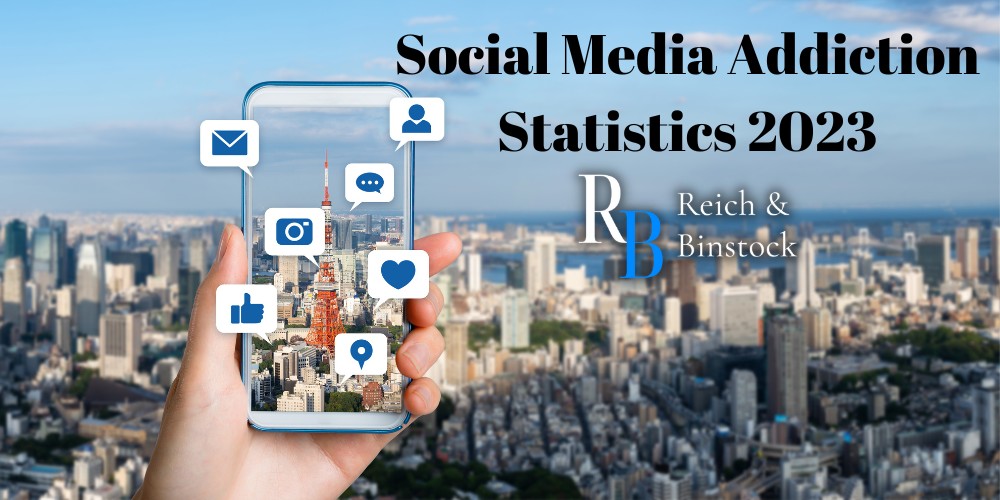Social networking sites have a myriad of uses, including sharing information, talking with friends and family, posting content, and much more. The ways in which social media sites can be used are nearly endless, especially since it is constantly evolving. However, there are dangers lurking just beneath the surface of certain social media apps. Developers of these apps want users to spend as much time as possible using their products. Therefore, they create algorithms that are addictive. This addictive programming has contributed to the social media addiction statistics we see today.
If you or someone you love has suffered harm or addiction from social media usage, you may be able to file a claim. Social media addiction lawsuits may be relatively new, but they have significant weight. A social media addict can suffer from a number of problems, including mental health issues, low self-esteem, negative body image, and much more. The Houston product liability lawyers at Reich & Binstock are here to help those who have suffered harm from social media addictions. To see if you have a case, please contact our office for a free consultation. Call today at 713-622-7271 or fill out our online intake form to schedule.
What Is Social Media?
According to the Oxford Languages dictionary, social media includes “websites and applications that enable users to create and share content or to participate in social networking.” It is a computer-based technology that allows Internet users to connect with others through virtual communities and networks. Users can access their social media accounts through their computers, smartphones, tablets, and certain other devices.
There are many benefits of social media usage. People can find positive, supportive communities from all over the world. They can also share important life events, photos, and videos with family members who live far away. However, social media apps have increasingly become the subject of scrutiny and suspicion because of their allegedly addictive nature. In this blog, we look at important social media statistics and identify the dangers of social media platforms today.
How Do People Use Social Media?

Social media network users don’t just post pictures of themselves and the food they eat. There are many ways in which people use the Internet and social media. Individuals can use it to connect or communicate with others. Businesses can use it to sell products and communicate with consumers. Researchers can even use it to conduct surveys and collect data. Social media is an integral part of how we communicate, share information, and spread news.
How Much Time Do People Spend on Social Media Platforms?
Recent social media usage data tells us that people spend an average of nearly two and a half hours a day on social media. This average has steadily increased in recent years, climbing over 60% from 2021 to 2022. While averages may vary slightly in different countries or age groups, it is still increasing steadily. This could be attributed to the adjustments and changes made to social media platform algorithms. Developers of these platforms make more money when they have more users who spend more time on their apps. Therefore, having more addictive algorithms benefits them.
Unfortunately, these benefits do not outweigh the potential harm caused by social media addiction. Although the average person may not struggle with social media or Internet addiction, it is still alarming to see how much time children, teens, and young adults spend online.
How Many Active Social Media Users Are There in the World?
By the end of 2022, there were an estimated 4.59 billion active social media users. By the end of 2023, this number is projected to increase to 4.89 billion people. This is nearly 62%, more than half, of the current population of the entire world. Since the inception of social media, the number of platforms, users, and accounts have steadily increased.
What Are the Most Used Social Media Platforms?
As of the end of 2022, the biggest social media platform was Facebook, with a total of 2.9 billion monthly active users. This is a very significant percentage of the world’s population. Below, we list the top social media platforms in the world, as well as their number of monthly active users.
- Facebook: 2.9 billion
- YouTube: 2.56 billion
- WhatsApp: 2 billion
- Instagram: 1.47 billion
- WeChat: 1.26 billion
- TikTok: 1 billion
- Facebook Messenger: 988 million
- Douyin: 600 million
- QQ: 574 million
- Weibo: 573 million
Other popular platforms in North America include Snapchat, Pinterest, Twitter, Reddit, and LinkedIn.
What Is Social Media Addiction?

According to the Addiction Center, social media addiction is “a behavioral addiction that is characterized as being overly concerned about social media, driven by an uncontrollable urge to log on to or use social media, and devoting so much time and effort to social media that it impairs other important life areas.” Social media addicts will often experience mood changes, preoccupation with social media, increasing tolerance, withdrawal symptoms, interpersonal problems, and even relapses. These behaviors are very similar to what other addicts will experience.
Behavioral addictions are those which do not involve substances like drugs or alcohol. Instead, they involve behaviors or actions that a person becomes dependent on. Examples of other behavioral addictions include gambling, video games, shopping, plastic surgery, and even food. You may have even heard the term “adrenaline junkie,” which refers to someone who likes taking risks.
How Common Is Social Media Addiction?
The Addiction Center estimates that anywhere from 5% to 10% of Americans may be addicted to social media. Most social media platforms have the potential to be addictive, as users receive a rush of dopamine when they share information about themselves online. In fact, certain neuroscientists have studied the effects of social media on the brain. So, why is social media addictive?
A recent study by Harvard University explains that being on a social media platform and interacting with people lights up the reward area in the brain. This is the same area that lights up when people take addictive substances, such as drugs or alcohol. In this way, people can become addicted to social media both physically and psychologically.
If you are unsure of whether you or your child suffers from social media addiction, we recommend looking out for the following signs of addiction.
- Using social media to forget about real-life problems
- Becoming troubled or restless when they cannot access social media accounts
- Spending a large amount of time thinking about social media or about planning to use it
- Feeling increasing urges to use social media
- Trying and failing to reduce their use of social media
- Using social media to such an extent that it affects their life, work, or studies
Key Statistics About Social Media Addiction

It’s important to understand the major social media addiction stats at play. Different demographics of people have widely different experiences and interactions with social media. For example, each age group may have a different preferred social media platform. The number of users in each age group can also vary. In the following sections, we outline some of the most important social media statistics in terms of addiction.
Social Media Addiction Statistics by Gender
Social media habits differ greatly when it comes to gender. Generally, however, females in North America are more likely to use social media than males. The percentage of social media users by gender varies significantly depending on the platform in question. Below, we outline the percentages of users by gender for five popular platforms.
- Facebook users: 43.4% female and 56.6% male
- Instagram users: 49.3% female and 50.7% male
- Snapchat users: 53.8% female and 45.4% male
- Twitter users: 43.6% female and 56.4% male
- LinkedIn users: 42.8% female and 57.2% male
- YouTube users: 45% female and 55% male
- TikTok users: 59% female and 41% male
No matter someone’s gender, excessive social media use is still a possibility. If social media addiction occurs, it can lead to poor mental health, interpersonal relationship problems, and other negative effects.
Social Media Addiction Statistics by Age Group
In general, the older the age group, the less likely someone is to even use social media accounts, let alone be addicted to them. It may come as no surprise that younger people are far more likely to be social media users than older people. Below, we outline the percentages of people that use social media in each age group. These statistics come from the Pew Research Center.
- 18-29 group: 84% of people use social media
- 30-49 group: 81% of people use social media
- 50-64 group: 73% of people use social media
- 65 and older group: 45% of people use social media
As we can see, older social media users are in the minority. However, social media addiction effects can touch more than just the person who is addicted. It can also impact the friends and family members of the addicted person.
Social Media Addiction Statistics by Platform
There are many different types of social media accounts and platforms available to children, young adults, and other age groups. Even programs and apps that are not intended for use as social media platforms often have a social networking feature. The biggest social media platforms have widely varying users in terms of age. Below, we list data from the Pew Research Center on the percentage of teens who use certain platforms.
- YouTube: 95% of teens use it, with 19% saying they use it almost constantly
- TikTok: 67% of teens use it, with 16% saying they use it almost constantly
- Instagram: 62% of teens use it, with 10% saying they use it almost constantly
- Snapchat: 59% of teens use it, with 15% saying they use it almost constantly
- Facebook: 32% of teens use it, with 2% saying they use it almost constantly
As we can see, the number of younger social media users is much lower for Facebook and much higher for YouTube, TikTok, and Instagram. Older Internet users are more likely to use Facebook, which is a fairly recent development. Additionally, around 54% of teenagers say that it would be difficult for them to give up social media consumption.
What Age Group Is Most Addicted to Social Media?

The percentage of users that self-identify as social media addicts also varies widely. Around 9% of users in all age groups would say they are completely addicted to social media, while around 30% of users say they are somewhat addicted. Below, we outline each age group’s percentage in terms of being somewhat or completely addicted to social media.
- 18-22 age group: 40% are somewhat addicted, while 5% are completely addicted
- 23-38 age group: 37% are somewhat addicted, while 15% are completely addicted
- 39-54 age group: 26% are somewhat addicted, while 9% are completely addicted
- 55-64 age group: 21% are somewhat addicted, while 1% are completely addicted
Social media and Internet users who are young adults tend to be more susceptible to social media addiction than older adults. They are also more susceptible to developing mental health issues as a result.
How Does Social Media Affect Children, Teens, and Young Adults?
Social media addiction can impact different people in different ways, depending on how long they use it and what they use it for. Some of the ways in which social media accounts and addiction can affect young people include the following.
- Disruptions to sleep
- Exposure to bullying
- Rumor spreading
- Peer pressure
- Developing unrealistic views of other people
- Poor academic performance
- Ruined relationships
- Depression symptoms
- Developing eating disorders
- Exposure to online predators
- Anxiety
- Self-harm
- Suicidal ideations
- Low self-worth
- Social media withdrawal
- Other personal problems
Can I File a Lawsuit for Social Media Harm?

If you or your child has suffered from the negative effects of social media addiction, you may be entitled to compensation. In order to have a valid claim, you must be able to prove the following elements of a social media addiction lawsuit.
- You or your child may be addicted to social media.
- The addiction started when the victim was under the age of 25, which is when the brain became fully developed.
- The victim suffered actual harm (either psychological or physical) as a result of the social media addiction.
We strongly recommend speaking with a personal injury lawyer about your case. It can be extremely difficult to gather the evidence you need for a successful case on your own. The attorneys at Reich & Binstock are standing by to help you with your social media addiction claim.
Contact a Social Media Addiction Lawsuit Attorney
If you or your child has suffered physical, emotional, or psychological harm as a result of social media addiction, you may be entitled to compensation. The large companies that develop and program social media platforms are responsible for the addictive algorithms that produce dopamine loops in the brain. While the use of social media itself does not cause addiction, the algorithms that encourage users to spend more time on these platforms can contribute to it. To find out whether you have a claim for social media addiction, please contact the Houston product liability lawyers at Reich & Binstock. To schedule your free consultation, please call our office at 713-622-7271 today.













